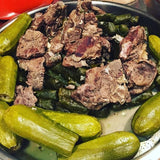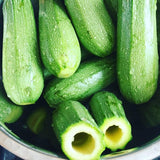Palestinian Kusa Squash
Cucurbita pepo
Stuff or grill this tender summer squash with your favorite Middle Eastern and Mediterranean recipes. Also known as Grey Squash, this type is beloved in Palestine, Lebanon, Syria, Egypt and most Arabic nations. The most common kusa dish is known as kousa mahshi (simply: "stuffed zucchini"), in which you remove the seeds and core of the kusa, and stuff it with rice and/or lamb, plus herbs and spices, boil, and serve as a main or side dish. Think stuffed peppers, but with kusa.
Kusa means zucchini in Arabic. Zucchini is plural for zucchino, the Italian word for small squash. Squash is short for askutasquash, the Narragansett word for "eaten green or raw." So what is the story of this cultivar? This species, Cucurbita pepo, originates in Mexico and Central America and now includes many types such as the New England pumpkin, acorn, scallop, straight neck, crook neck, and vegetable marrow. It is said that Christopher Columbus introduced this species to Europe and the Mediterranean region. In the mid-19th century, Italians developed the zucchini, perhaps by selecting cultivars of the vegetable marrow type for cylindrical, green fruits that were tasty in their immature stage.
It is difficult to determine which came first, the zucchini or the modern kusa. In his fairly thorough 1794 book "The Natural History of Aleppo," Alexander Russell describes an "orange-shaped pumpion" (Kusa Siffer - Cucurbita) and "several varieties of gourd" (Kurrah - Cucurbita pepo). In 1901, the Encyclopædia Biblica mentioned "various gourds are included [in the] Mishna, among them perhaps the favourite kusa or vegetable-marrow," however, the Mishna was written from oral tradition around 200AD, so his conjecture is almost definitely wrong, yet illuminating. From these two sources, we can see that the much adored kusa probably emerged in the 19th century Middle East around the same time the zucchini emerged in Italy.
Palestinian chef and educator Anan Zahr shared these seeds and these food photos with us. Glimpse her Palestinian kitchen and culinary journey on Instagram at @ananzahr. This is a productive bush variety of summer squash.
Days to maturity: 48 from transplant
Seeds per pack: 10-14
Germination rate: 98% on 01/21/2025
Planting / harvesting notes
Direct sow in warm soil after the last frost, or seed indoors 2-3 weeks beforehand and transplant. Space at least 18" apart in the row as this variety grows in a bush habit. If concerned about vine borers, consider covering with row cover until plants are large. Avoid downy mildew by watering only at the base of the plant (not on the leaves!). Harvest fruits when 5-6" long, young, and tender (like a zucchini).
Seed keeping notes
Squash are insect pollinated and require about 1/2 a mile of isolation from other varieties of the same species, which in this case is C. pepo. The seeds will be fully mature when the fruit gets large, the colors get darker, and the stem of the fruit has turned brown and woody. Separate the seeds from the flesh, rinse them, and dry them on a screen or paper product away from direct sunlight in a ventilated place. The plumpest and hardest seeds will be most viable.
Other spellings: Kousa, Koussa, Coussa, Gray Squash, Mexican Grey Squash, Calabacita.
Sources:
Natural History of Aleppo. Alexander Russell. 1794
Encyclopædia Biblica: A Critical Dictionary of the Literary, Political and Religious History, the Archæology, Geography, and Natural History of the Bible, Volume 2, Thomas Kelly Cheyne, John Sutherland Black Macmillan, 1901
Historical records, origins, and development of the edible cultivar groups of Cucurbita pepo (Cucurbitaceae). Article by Harry Paris. Economic Botany. October 1989







